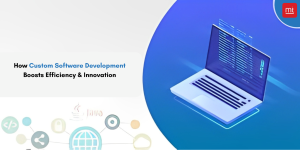The Evolution of Trading Software Development: Powering the Financial World

In the fast-paced world of financial markets, professional trading software development services have become the backbone of operations for investment firms and individual traders alike. The development of trading software has undergone a remarkable transformation, evolving from simple order execution platforms to complex algorithmic systems.
The Evolution of Trading Software
The development of trading software has undergone a remarkable transformation, evolving from simple order execution platforms to complex algorithmic systems. Now, let’s delve into professional trading software development services, starting from its evolution.
A Historical Perspective
Trading software has come a long way since the early days of stock markets. Initially, trading was done manually, with traders shouting orders on the exchange floor. The transition to electronic commerce in the late 20th century marked a significant milestone. Computer-based systems revolutionized the industry, allowing faster execution and increased efficiency.
Algorithmic Trading
The next major leap in commerce software development was the emergence of algorithmic trading. Algorithms enabled traders to execute complex strategies automatically. These algorithms could process vast amounts of data and respond to market changes in real time, providing a competitive edge. Today, algorithmic commerce is a cornerstone of the financial industry.
High-Frequency Trading (HFT)
High-frequency trading represents another evolutionary step. HFT systems use advanced algorithms to execute many orders within milliseconds. This is made possible through low-latency connections and cutting-edge hardware. HFT has reshaped markets, contributing to increased liquidity and market efficiency.
Critical Components of Trading Software Development
Developing software for trading is a multifaceted process that requires careful attention to various critical components. These components are essential to creating a robust and efficient system that meets the ever-evolving demands of financial markets. Let’s explore these fundamental elements in detail:
Data Feeds and Analysis
One of the fundamental components of any IT company using fintech software development solutions is data feeds. Real-time market data, news, and economic indicators are essential for making informed decisions. Software developers must integrate data feeds, process the information, and provide traders with actionable insights.
Execution Algorithms
Execution algorithms are at the core of any app or website. These algorithms determine when and how orders are executed. Developers create algorithms that optimize execution to minimize slippage and maximize profits. Different strategies, such as market orders, limit orders, and stop orders, are implemented within these algorithms.
Risk Management
Risk management is paramount in software development. Systems must incorporate risk controls to protect traders from catastrophic losses. Features like stop-loss orders and position size limits are essential in preventing unexpected market events from causing irreparable damage.
User Interfaces
User interfaces have evolved to become more intuitive and user-friendly. Traders need easy-to-navigate platforms with customizable layouts and advanced charting tools. A well-designed interface is crucial for traders to monitor positions, execute orders, and access the necessary data.
Security and Compliance
Security is a top priority in software development. Protecting sensitive data, secure access, and encryption are essential components. Additionally, compliance with regulatory standards is non-negotiable. Developers must ensure that the website or app complies with industry regulations, such as Know Your Customer (KYC) and Anti-Money Laundering (AML) requirements.
The Role of Trading Software Today
As we already know, modern trading software plays a pivotal role in the world of finance, shaping the way markets operate and enabling traders to navigate the complexities of the global financial landscape. Its significance extends beyond mere execution, and its impact is felt in various aspects of the industry. Here, we explore the multifaceted role of software in today’s financial world:
Accessibility and Inclusivity
Modern trading software has made financial markets more accessible to a broader audience. With the advent of online brokerages and mobile apps, retail investors can now participate in markets once reserved for institutional players. This inclusivity has democratized investing.
Market Efficiency
Trading software has significantly improved market efficiency. Algorithms execute trades with incredible speed and precision, leading to tighter bid-ask spreads and reduced price discrepancies. As a result, markets have become more efficient and liquid, benefiting all participants.
Competition and Innovation
The competitive landscape in the financial industry has intensified due to e-commerce platforms. Firms continuously innovate and develop new strategies and technologies to gain a competitive edge. This constant evolution drives innovation, benefiting both traders and investors.
Risk Management and Regulation
E-commerce platforms have also improved risk management and regulatory compliance. Automated risk controls help prevent catastrophic losses, while robust compliance features ensure adherence to industry regulations. This has created a safer and more transparent environment.
Conclusion
The evolution of trading software development has transformed the financial world, from manual commerce on exchange floors to algorithmic and HFT on electronic platforms. Key components such as data feeds, execution algorithms, risk management, user interfaces, and security are pivotal in developing such software. Today, e-commerce platforms are vital in making financial markets more accessible, efficient, competitive, and compliant. As technology continues to advance, we can expect even more exciting developments in the realm of commerce software.
Frequently Asked Questions
What is algorithmic trading?
Algorithmic trading, often referred to as algo trade, is a strategy that uses computer algorithms to execute orders in financial markets automatically. These algorithms can process data, make sound decisions, and manage orders with minimal human intervention.
How does high-frequency trading (HFT) work?
High-frequency trading involves executing many orders in extremely short timeframes, often within milliseconds. HFT systems rely on low-latency connections to exchanges, advanced algorithms, and high-speed hardware to identify and capitalize on short-term market inefficiencies.
What are risk management features in trading software?
Risk management features in commerce platforms are tools designed to mitigate potential losses. These features can include stop-loss orders, position size limits, margin requirements, and risk assessment algorithms to protect traders from substantial losses in volatile markets.
How has trading software improved market efficiency?
Trading software has improved market efficiency by executing trades rapidly and accurately, leading to tighter bid-ask spreads and reduced price discrepancies. This increased efficiency benefits all market participants by providing fairer and more liquid markets.
What is the role of compliance in trading software development?
Compliance in trading software development ensures that the app or website adheres to industry regulations and standards, such as Know Your Customer (KYC) and Anti-Money Laundering (AML) requirements. Compliance features help prevent illegal activities and protect both traders and the financial system from fraudulent behavior.






